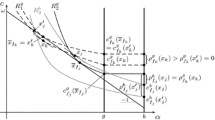Abstract
Lifestyle can often affect the likelihood an individual will have a future illness. Subsidies often mitigate the consequences of poor lifestyle choices. In this paper we explore tax-subsidy policies that lower the consequences of incurring ill health. We find that a funding mechanism consistent with current US policy lowers the investment in healthy lifestyles by both the wealthy, who pay taxes, and the poor, who receive subsidies. We also explore alternative policy interventions such as investing in research to lessen the impact or probability of the disease.
Similar content being viewed by others
References
Becker, G., & Murphy, K. (1988). The theory of rational addiction. Journal of Political Economy, 96, 675–700.
Bednarek, H., & Pecchenino, R. (2002). A macroeconomic analysis of publicly funded health care. Journal of Public Economic Theory, 4, 243–270.
Bednarek, H., Jeitschlo, T., & Pecchinino, R. (2006). Gluttony and sloth v. bliss? A theory of choice in the presence of behavioral adjustment costs. B.E. Journal Contributions to Economic Analysis and Policy 5, article 6.
Bednarek, H., Pecchenino, R., & Stearns, S. (2008). Do your neighbors influence your health? Journal of Public Economic Theory, 10, 301–315.
Bhattacharya, J., Bundorf, K., Pace, N., & Sood, N. (2009). Does health insurance make you fat? Working Paper 15163, National Bureau of Economic Research, Cambridge, MA.
CDC (2006). State-specific prevalence of obesity among adults—United States, 2005. Morbidity and Mortality Weekly Report (MMWR), 55, 985–988.
CDC (2010). Chronic Diseases and health promotion. http://www.cdc.gov/chronicdisease/overview/index.htm. Last accessed February 2, 2010.
Chang, F. (1996). Uncertainty and investment in health. Journal of Health Economics, 15, 369–376.
Courbage, C., & Coulon, A. (2004). Prevention and private health insurance in the U.K. The Geneva Papers on Risk and Insurance, 29, 719–727.
Cropper, M. L. (1977). Health, investment in health and occupational choices. Journal of Political Economy, 85, 1273–1294.
Cutler, D. (2008). Are we finally winning the war on cancer? Journal of Economic Perspectives, 22(4), 3–26.
Dubay, L., & Kenney, G. (1997). Did Medicaid expansions for pregnant women crowd out private coverage? Health Affairs, 16, 185–206.
Ehrlich, I., & Becker, G. (1972). Market insurance and self-protection. Journal of Political Economy, 40, 623–648.
Feldstein, M. (1999). Prefunding Medicare. American Economic Review, 89, 222–227.
Grossman, M. (1972). On the concept of health capital and the demand for health. Journal of Political Economy, 80, 223–255.
Harrison, G. W., Lau, M. I., & Williams, M. B. (2002). Estimating individual discount rates in Denmark: a field experiment. American Economic Review, 92(5), 1606–1617.
Hubbard, R., Skinner, J., & Zeldes, S. (1995). Precautionary savings and social insurance. Journal of Political Economy, 103, 360–399.
Internal Revenue Service (2009). Individual income and tax data, by state and size of adjusted gross income for 2007. http://www.irs.gov/taxstats/article/0,,id=171535,00.html. Last accessed February 2, 2010.
Komlos, J., Smith, P., & Bogin, B. (2004). Obesity and the rate of time preference: is there a connection?. Journal of Biosocial Science, 36, 209–219.
Lawrence, E. C. (1991). Poverty and the rate of time preference: evidence from panel data. The Journal of Political Economy, 99(1), 54–77.
Lee, J., McClellan, M., & Skinner, J. (1999). Distributional effects of Medicare. In J. Poterba (Ed.), Tax policy and the economy (Vol. 13). Cambridge: MIT Press.
Levy, A. (2002). Rational eating: can it lead to overweightness or underweightness? Journal of Health Economics, 21, 887–899.
Liljas, B. (1998). The demand for health with uncertainty and insurance. Journal of Health Economics, 17, 153–170.
Manson, J., & Bassuk, S. (2003). Obesity in the United States: a fresh look at its high toll. Journal of the American Medical Association, 289, 229–230.
McClellan, M., & Skinner, J. (1997). The incidence of Medicare. NBER Working Paper #6013.
Must, A., Spadano, J., Coakley, E., Field, A., Colditz, G., & Dietz, W. (1999). The disease burden associated with overweight and obesity. Journal of the American Medical Association, 282, 1523–1529.
NIH (2005). Replacing some carbohydrates with protein and unsaturated fat may enhance heart health benefits. http://www.nhlbi.nih.gov/new/press/05-11-15a.htm. Last accessed February 2, 2010.
NIH (2010). Dietary supplement fact sheet: vitamin D. http://www.ods.od.nih.gov/factsheets/vitamind.asp. Last accessed February 2, 2010.
Pauly, M. V. (1968). The economics of moral hazard. American Economic Review, 58(3), 531–537.
Phelps, C. E. (2003). Health economics (3rd edn.). New York: Addison-Wesley.
Picone, G., Wilson, M., & Uribe, M. (1998). The effect of uncertainty on the demand for medical care, health capital and wealth. Journal of Health Economics, 17, 171–185.
Pope, S., Shue, V., & Beck, C. (2003). Will a healthy lifestyle help prevent Alzheimer’s disease? Annual Review of Public Health, 24, 111–131.
Preston, S., & Ho, J. (2009). Low life expectancy in the United States: is the health care system at fault? Working Paper 15213, National Bureau of Economic Research: Cambridge, MA.
Smith, T., & Tasnadi, A. (2007). A theory of natural addiction. Games and Economic Behavior, 59, 316–344.
Author information
Authors and Affiliations
Corresponding author
Rights and permissions
About this article
Cite this article
Rosenman, R. The public finance of healthy behavior. Public Choice 147, 173–188 (2011). https://doi.org/10.1007/s11127-010-9611-z
Received:
Accepted:
Published:
Issue Date:
DOI: https://doi.org/10.1007/s11127-010-9611-z




